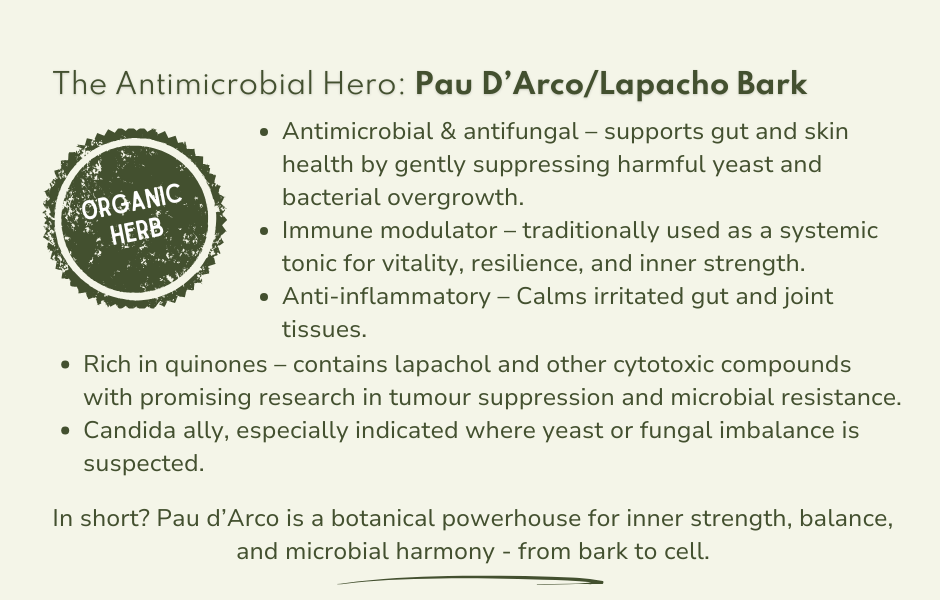PAU D'ARCO / LAPACHO (Tabebuia impeteginosa) *Organic herb for horses
Benefits of Pau D'Arco/Lapacho Bark for Horses
A revered inner-bark remedy from the Amazon, Pau d’Arco supports the gut, skin, and immune system with potent anti-fungal, anti-inflammatory, and antimicrobial action.
Please note this is a nutritional, functional horse food supplement and not veterinary medicine.
For more on this, see Dr Kellon's Horse Sense - Nutrition is not 'Alternative' Therapy
.

Find Pau/Lapacho in the EquiNatural range
We blend Pau D'Arco into many of our blends due to its potent antibacterial properties, specifically our BioCARE, BiomeTonic, EyeTonic, LKLCARE, LymeCARE, MetaTonic, and OptimaCARE
💧Organic Pau D'Arco/Lapacho Tincture
Our human-grade, certified organic tinctures give you a ready-to-absorb potent source of phytonutrients at the highest-strength available, for immediate absorption straight into the bloodstream and to the body’s cells.
- Hydroanthas impeteginosa (Pau D'Arco/Lapacho Tree)
- Inner Bark
- Decocted 1:3 35%
- Wild Harvested
~ Feed Guide - pau d'arco/lapacho tincture for horses
- 6ml/100kg bodyweight, daily in feed.
- Our tinctures come in a heat-sealed, twin-neck, child-resistant HDPE plastic dosing bottle, complete with dosing chamber. ♻️ HDPE is recyclable and low-impact - aligned with our sustainability ethos.
🌿Organic Dried Pau D'Arco/Lapacho Bark
Grown, harvested and dried without the use of agri-chemicals, non-irradiated and GMO free - see our Quality page for Quality Management & Certification Documents.
- Hydroanthas impeteginosa (Pau D'Arco/Lapacho Tree) Inner Bark, Origin Brazil (Not certified organic)
- Inner Bark
- Wild Harvested
- Origin Brazil
~ Feed Guide - dried pau d'arco/lapacho bark for horses
- 5g/100kg bodyweight per day, i.e. 25g for a 500kg horse.
- ♻️Supplied in a 100% fully recylable, resealable, food-grade foil pouch for freshness.
🟤Organic Ground Pau D'Arco/Lapacho Barks
Grown, harvested and dried without the use of agri-chemicals, non-irradiated and GMO free - see our Quality page for Quality Management & Certification Documents.
- Tabebuia impeteginosa (Pau D'Arco/Lapacho Tree)
- Inner Bark, Ground
- Wild Harvested
- Origin Brazil
~ Feed Guide - ground dried pau d'arco/lapacho bark for horses
- 5g/100kg bodyweight per day, i.e. 25g for a 500kg horse.
- ♻️Supplied in a 100% fully recylable, resealable, food-grade foil pouch for freshness.
Footnotes
- Laboratory tested for identification and compliance to the British and European Pharmacopoeia standards.
- Human grade.
- Please be aware that if you're purchasing our dried botanicals for human use, our dried range is cut to appropriate sizes for feeding to horses.
- ♻️ Eco Note: Our packaging is recyclable and refillable.
- 🧊 Storage Tip: Keep cool and dry.
Functional Nutritional Value
Constituents: Naphthoquinones such as lapachol, lapachone and xyloidone ; phenolic acids such as veratric acid ; tannins; coumarins; flavonoids; catechins; calcium oxalate, iridoids, carnosol.
Pau D'Arco/Lapacho in History & Tradition
Bold, pink-blossomed, and full of life, Pau d’Arco(also known as Lapacho Bark or Ipê Roxo) is a sacred South American tree with a bark that holds centuries of healing wisdom. Its botanical name, Tabebuia impetiginosa , refers to its age-old use in skin infections ( impetigo ) - but this vibrant inner bark is equally valued for deeper immune, gut, and systemic support.
Known as the Pink Trumpet Tree, it grows tall and proud across South American streets and forests, feeding bees and hummingbirds while quietly powering herbal tonics, teas, and poultices across Amazonian, Guarani, and Tupi cultures. Its name, pau d’arco , literally means ‘bow stick’- a nod to its historic use in bow-making - but it’s the bark, not the wood, that has captured herbalists' attention.
Traditional wisdom
Across the continent, indigenous tribes have long used Pau d’Arco for:
- Skin disorders (eczema, fungal infections, sores, psoriasis, wounds)
- Yeast conditions like Candida albicans, internally and externally
- Digestive inflammation and dysbiosis-related discomfort
- Chronic infections, snakebites, and fevers
- Circulatory issues and degenerative conditions
- Energy and resilience, as a vitality tonic for strength and recovery
In Argentina and Costa Rica, it’s used for diarrhoea, urinary and respiratory infections, colds, and pharyngitis. In Mexico, it’s traditionally employed in fever, uterine and head pain, and anaemia.
But perhaps most importantly, it has been widely valued as a systemic cleanser, used to clear stubborn imbalances from the gut, joints, and skin.
What the science says
Research into Pau d’Arco focuses on its potent naphthoquinone compounds — particularly lapachol, a phytochemical that shows antifungal, anti-inflammatory, antibacterial, cytotoxic, and antitumor actions.
- Immune & microbial balance – An in vitro study showed Pau d’Arco bark extract inhibits E. coli growth while leaving friendly gut bacteria unharmed - making it an exceptional herb for selective pathogen management without microbiome disruption.
- Candida & yeast overgrowth – Particularly indicated for candidiasis, Pau d’Arco may help restore balance in horses with suspected fungal dysbiosis, skin yeast infections, or gut:immune imbalance.
- Cytotoxic potential – Preliminary human research has shown that lapachol may help reduce tumour size and pain, though large-scale trials have been limited due to gastrointestinal side effects at high doses (Santana et al., 1980; Cragg & Newman, 2005).
- Anti-inflammatory & analgesic – Its ability to calm inflammatory cascades and act as a gentle pain reliever adds to its value in systemic protocols.
Despite early pharmaceutical interest being halted, ongoing herbal studies suggest its benefits are due to a synergy of multiple quinone compounds, not just lapachol alone. Its multi-targeted botanical intelligence makes it a continued favourite in natural wellness protocols.
© EquiNatural 2025. All content is original work protected under copyright, and may not be re-published, duplicated, or rewritten for commercial use without permission.


